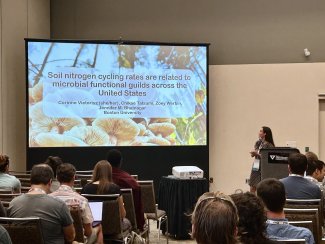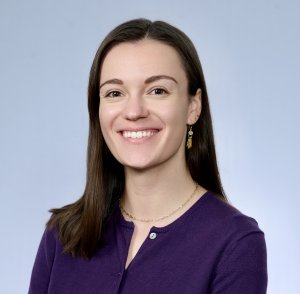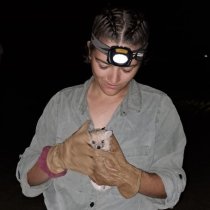Featured Expert: PhD Candidate Corinne Vietorisz - ESA “Best NEON Presentation” Awardee
September 29, 2025
This year's Ecological Society of America (ESA) Annual Meeting was a wonderful reminder that it’s important to recognize the achievements of researchers and ecologists, as the work they do continues to serve the nation and further ecological innovations. While there were dozens of exceptional presentations this year, one stood out in particular. Corinne Vietorisz, a PhD candidate at Boston University, received the Best NEON Presentation Award for her research on how microbes regulate soil nutrients. Her work demonstrates how NEON data can advance scientific understanding of biological diversity and ecosystem processes.
This award for oral presenters, launched by NEON at ESA 2025, is the first of its kind and reflects its commitment to showcasing the impact of NEON’s openly available data, samples, and infrastructure. NEON hopes to drive even more interest in future years as the award continues to highlight outstanding ecological research enabled by NEON.
A Look into Vietorisz’s Findings
Vietorisz’s research delves into understanding how diverse microbial groups influence nitrogen cycling, a process essential to plant growth, carbon storage, and ecosystem health. While she collected data in local fieldwork in Massachusetts, she was able to utilize NEON’s data to compare her discoveries with other regions. Using the expanded dataset she was able to test whether relationships she observed in one region held true across diverse ecosystems nationwide.

“So much of what we don’t understand is which microbial groups are associated with nutrient cycling at large spatial scales,” Vietorisz said. “Before we can ask more complex questions, we need that baseline knowledge.”
Interestingly, she found that tree root symbiotic fungi were important in explaining net ammonification, the release of inorganic nitrogen from organic matter. Strong correlations between tree root symbiotic fungi and net ammonification were found in dry soils, evergreen forests, and ecosystems with low abundances of these symbiotic fungi, which was surprising.
NEON data helped Vietorisz with her overall research question especially when she realized that both larger groups and specific classes of bacteria mattered for explaining net nitrification. “We found that nitrification was strongly associated with copiotrophic bacteria,” Vietorisz said. “That relationship was strongest in environments with high pH, high inorganic nitrogen, hot temperatures and low moisture, conditions you might also find in urban ecosystems.”
NEON’s Data Unlocks Big Insights
ESA25 was pivotal in building connections with other ecologists, and gaining a better insight into NEON data for Vietorisz. Vietorisz said that conversations with NEON staff at the event helped her link nitrification and pathogenic fungi in pasture-hay systems, and that NEON staff explained the grazing practices at those select field sites. The event enabled discussions between experts about NEON data, which can be pivotal to uncovering unexpected connections, like those between soil processes, agriculture and microbial diversity.
Vietorisz had the opportunity to converse with scientists at ESA who build complex nutrient cycling models that can help her work moving forward. There is emphasis when it comes to research on microbial ecology and including microbes in data models. “This kind of data is necessary to parameterize models and include microbes in models, because right now they’re barely included,” said Vietorisz. Improving the data models can help with predicting ecological change and better inform land and water management across the country.
Vietorisz is one of many who can speak to how a standardized NEON dataset can help provide access to knowledge for researchers, policymakers and communities preparing for a changing world. “What’s so impactful is the standardization. It allows us to answer questions at big scales. Without that, you just never know if your findings are local quirks or broader truths.”


